Pre-Admission Facility and Patient Care: A Case Study of Ethel
VerifiedAdded on 2022/11/19
|14
|3892
|383
AI Summary
This document is a case study of Ethel, a patient who underwent knee surgery. It discusses the advantages of pre-admission facility, patient care, Alzheimer's, diabetes, hypertension, and more. It also provides expert solutions for nursing assignments.
Contribute Materials
Your contribution can guide someone’s learning journey. Share your
documents today.
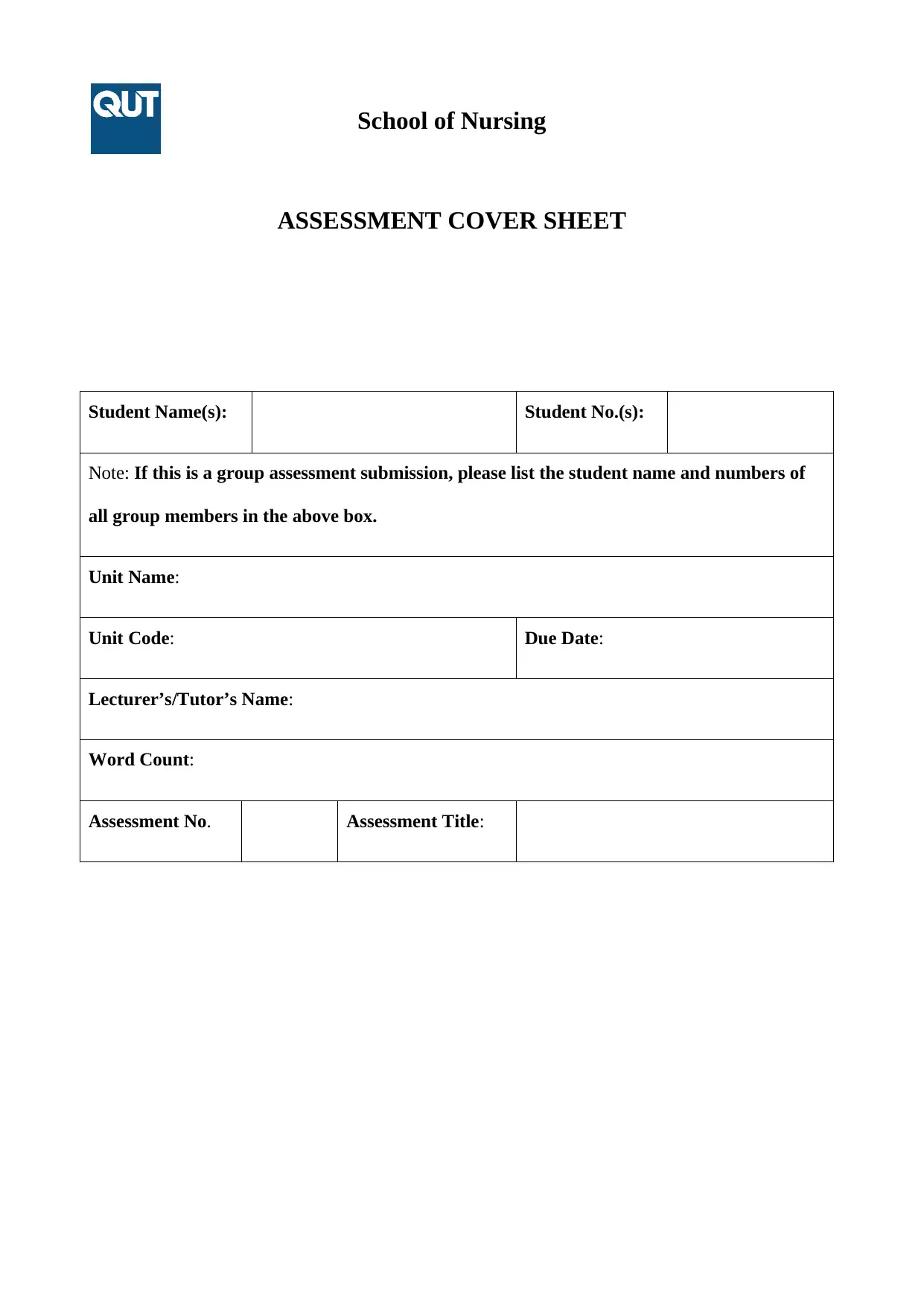
School of Nursing
ASSESSMENT COVER SHEET
Student Name(s): Student No.(s):
Note: If this is a group assessment submission, please list the student name and numbers of
all group members in the above box.
Unit Name:
Unit Code: Due Date:
Lecturer’s/Tutor’s Name:
Word Count:
Assessment No. Assessment Title:
ASSESSMENT COVER SHEET
Student Name(s): Student No.(s):
Note: If this is a group assessment submission, please list the student name and numbers of
all group members in the above box.
Unit Name:
Unit Code: Due Date:
Lecturer’s/Tutor’s Name:
Word Count:
Assessment No. Assessment Title:
Secure Best Marks with AI Grader
Need help grading? Try our AI Grader for instant feedback on your assignments.
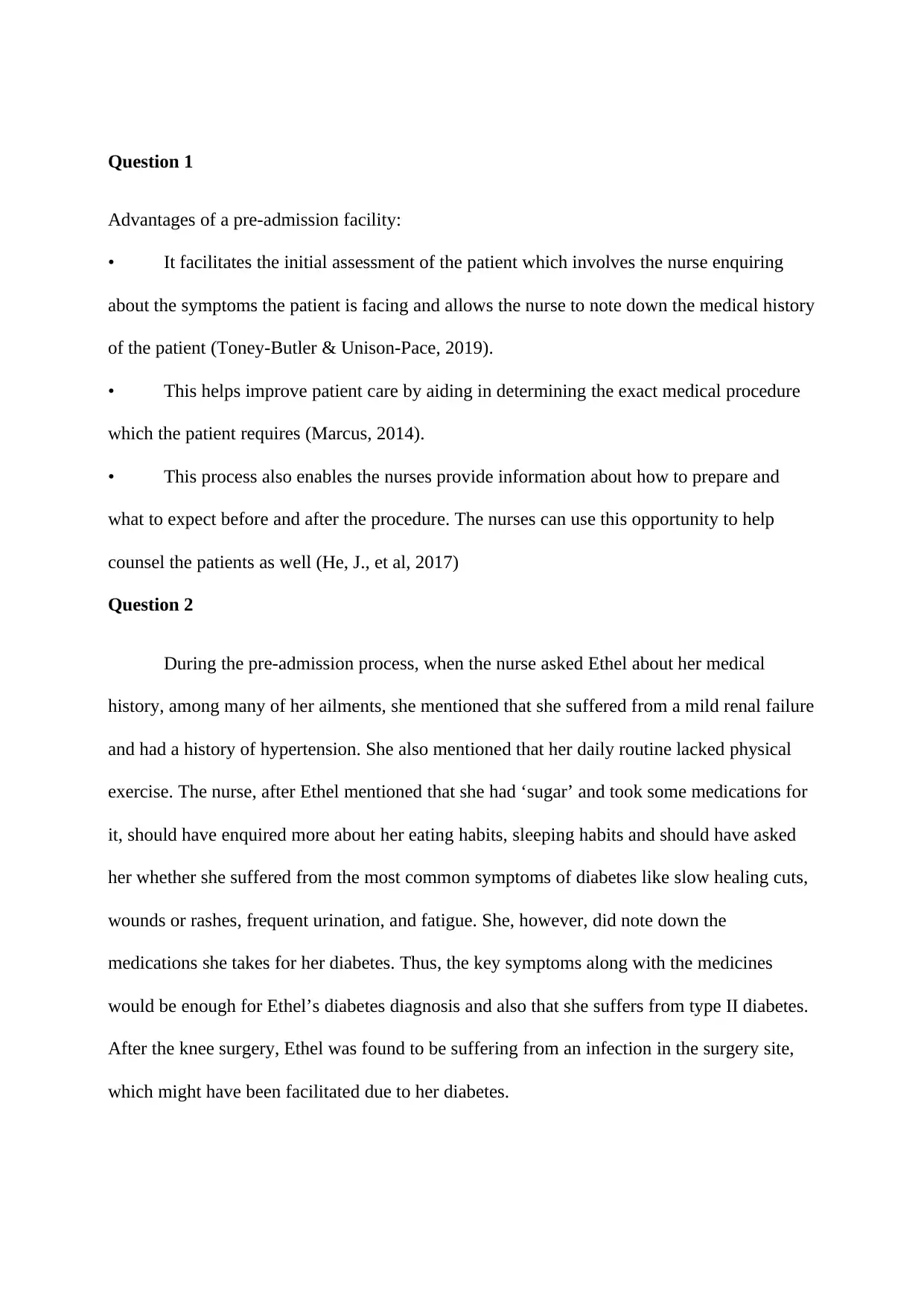
Question 1
Advantages of a pre-admission facility:
• It facilitates the initial assessment of the patient which involves the nurse enquiring
about the symptoms the patient is facing and allows the nurse to note down the medical history
of the patient (Toney-Butler & Unison-Pace, 2019).
• This helps improve patient care by aiding in determining the exact medical procedure
which the patient requires (Marcus, 2014).
• This process also enables the nurses provide information about how to prepare and
what to expect before and after the procedure. The nurses can use this opportunity to help
counsel the patients as well (He, J., et al, 2017)
Question 2
During the pre-admission process, when the nurse asked Ethel about her medical
history, among many of her ailments, she mentioned that she suffered from a mild renal failure
and had a history of hypertension. She also mentioned that her daily routine lacked physical
exercise. The nurse, after Ethel mentioned that she had ‘sugar’ and took some medications for
it, should have enquired more about her eating habits, sleeping habits and should have asked
her whether she suffered from the most common symptoms of diabetes like slow healing cuts,
wounds or rashes, frequent urination, and fatigue. She, however, did note down the
medications she takes for her diabetes. Thus, the key symptoms along with the medicines
would be enough for Ethel’s diabetes diagnosis and also that she suffers from type II diabetes.
After the knee surgery, Ethel was found to be suffering from an infection in the surgery site,
which might have been facilitated due to her diabetes.
Advantages of a pre-admission facility:
• It facilitates the initial assessment of the patient which involves the nurse enquiring
about the symptoms the patient is facing and allows the nurse to note down the medical history
of the patient (Toney-Butler & Unison-Pace, 2019).
• This helps improve patient care by aiding in determining the exact medical procedure
which the patient requires (Marcus, 2014).
• This process also enables the nurses provide information about how to prepare and
what to expect before and after the procedure. The nurses can use this opportunity to help
counsel the patients as well (He, J., et al, 2017)
Question 2
During the pre-admission process, when the nurse asked Ethel about her medical
history, among many of her ailments, she mentioned that she suffered from a mild renal failure
and had a history of hypertension. She also mentioned that her daily routine lacked physical
exercise. The nurse, after Ethel mentioned that she had ‘sugar’ and took some medications for
it, should have enquired more about her eating habits, sleeping habits and should have asked
her whether she suffered from the most common symptoms of diabetes like slow healing cuts,
wounds or rashes, frequent urination, and fatigue. She, however, did note down the
medications she takes for her diabetes. Thus, the key symptoms along with the medicines
would be enough for Ethel’s diabetes diagnosis and also that she suffers from type II diabetes.
After the knee surgery, Ethel was found to be suffering from an infection in the surgery site,
which might have been facilitated due to her diabetes.
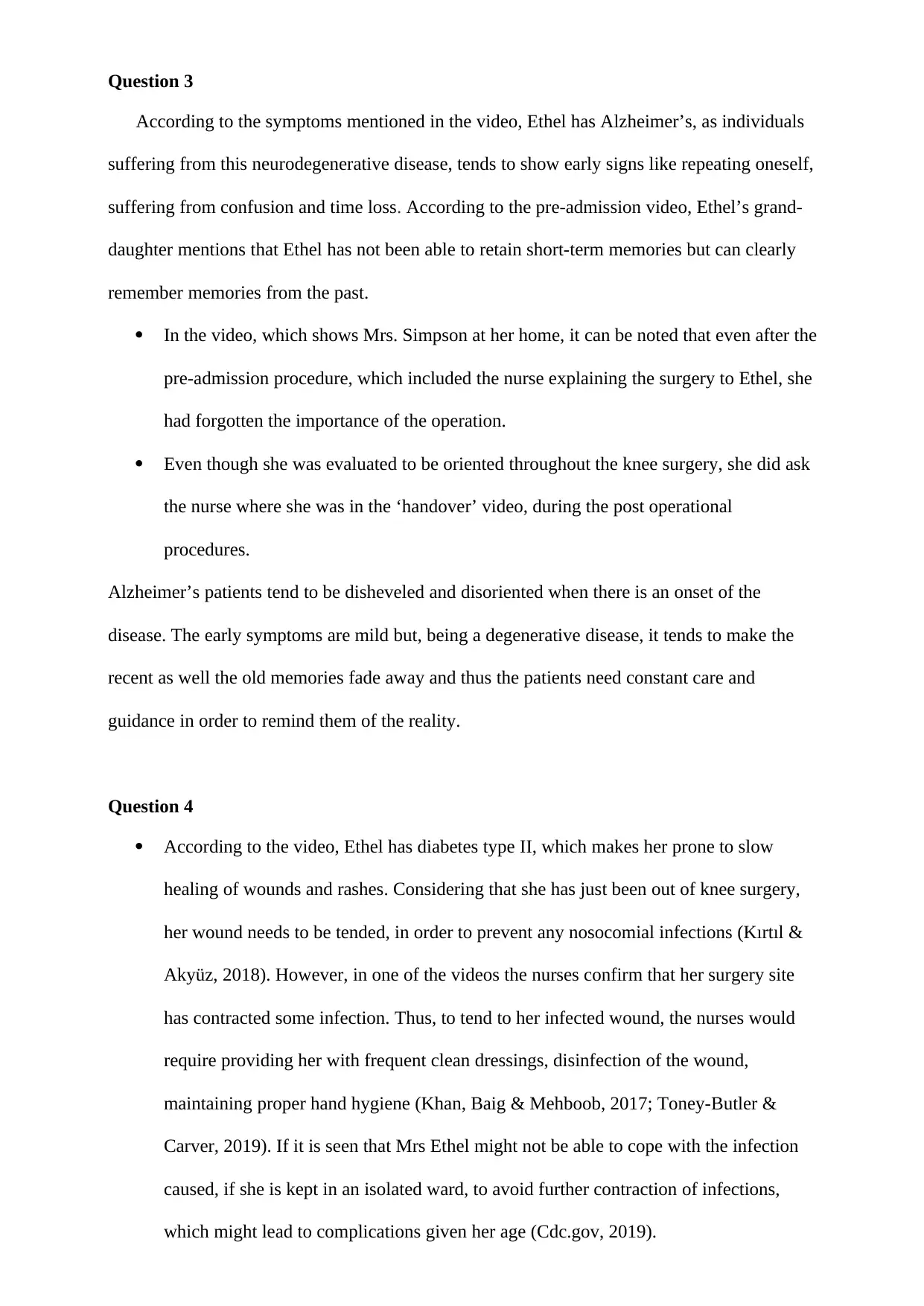
Question 3
According to the symptoms mentioned in the video, Ethel has Alzheimer’s, as individuals
suffering from this neurodegenerative disease, tends to show early signs like repeating oneself,
suffering from confusion and time loss. According to the pre-admission video, Ethel’s grand-
daughter mentions that Ethel has not been able to retain short-term memories but can clearly
remember memories from the past.
In the video, which shows Mrs. Simpson at her home, it can be noted that even after the
pre-admission procedure, which included the nurse explaining the surgery to Ethel, she
had forgotten the importance of the operation.
Even though she was evaluated to be oriented throughout the knee surgery, she did ask
the nurse where she was in the ‘handover’ video, during the post operational
procedures.
Alzheimer’s patients tend to be disheveled and disoriented when there is an onset of the
disease. The early symptoms are mild but, being a degenerative disease, it tends to make the
recent as well the old memories fade away and thus the patients need constant care and
guidance in order to remind them of the reality.
Question 4
According to the video, Ethel has diabetes type II, which makes her prone to slow
healing of wounds and rashes. Considering that she has just been out of knee surgery,
her wound needs to be tended, in order to prevent any nosocomial infections (Kırtıl &
Akyüz, 2018). However, in one of the videos the nurses confirm that her surgery site
has contracted some infection. Thus, to tend to her infected wound, the nurses would
require providing her with frequent clean dressings, disinfection of the wound,
maintaining proper hand hygiene (Khan, Baig & Mehboob, 2017; Toney-Butler &
Carver, 2019). If it is seen that Mrs Ethel might not be able to cope with the infection
caused, if she is kept in an isolated ward, to avoid further contraction of infections,
which might lead to complications given her age (Cdc.gov, 2019).
According to the symptoms mentioned in the video, Ethel has Alzheimer’s, as individuals
suffering from this neurodegenerative disease, tends to show early signs like repeating oneself,
suffering from confusion and time loss. According to the pre-admission video, Ethel’s grand-
daughter mentions that Ethel has not been able to retain short-term memories but can clearly
remember memories from the past.
In the video, which shows Mrs. Simpson at her home, it can be noted that even after the
pre-admission procedure, which included the nurse explaining the surgery to Ethel, she
had forgotten the importance of the operation.
Even though she was evaluated to be oriented throughout the knee surgery, she did ask
the nurse where she was in the ‘handover’ video, during the post operational
procedures.
Alzheimer’s patients tend to be disheveled and disoriented when there is an onset of the
disease. The early symptoms are mild but, being a degenerative disease, it tends to make the
recent as well the old memories fade away and thus the patients need constant care and
guidance in order to remind them of the reality.
Question 4
According to the video, Ethel has diabetes type II, which makes her prone to slow
healing of wounds and rashes. Considering that she has just been out of knee surgery,
her wound needs to be tended, in order to prevent any nosocomial infections (Kırtıl &
Akyüz, 2018). However, in one of the videos the nurses confirm that her surgery site
has contracted some infection. Thus, to tend to her infected wound, the nurses would
require providing her with frequent clean dressings, disinfection of the wound,
maintaining proper hand hygiene (Khan, Baig & Mehboob, 2017; Toney-Butler &
Carver, 2019). If it is seen that Mrs Ethel might not be able to cope with the infection
caused, if she is kept in an isolated ward, to avoid further contraction of infections,
which might lead to complications given her age (Cdc.gov, 2019).
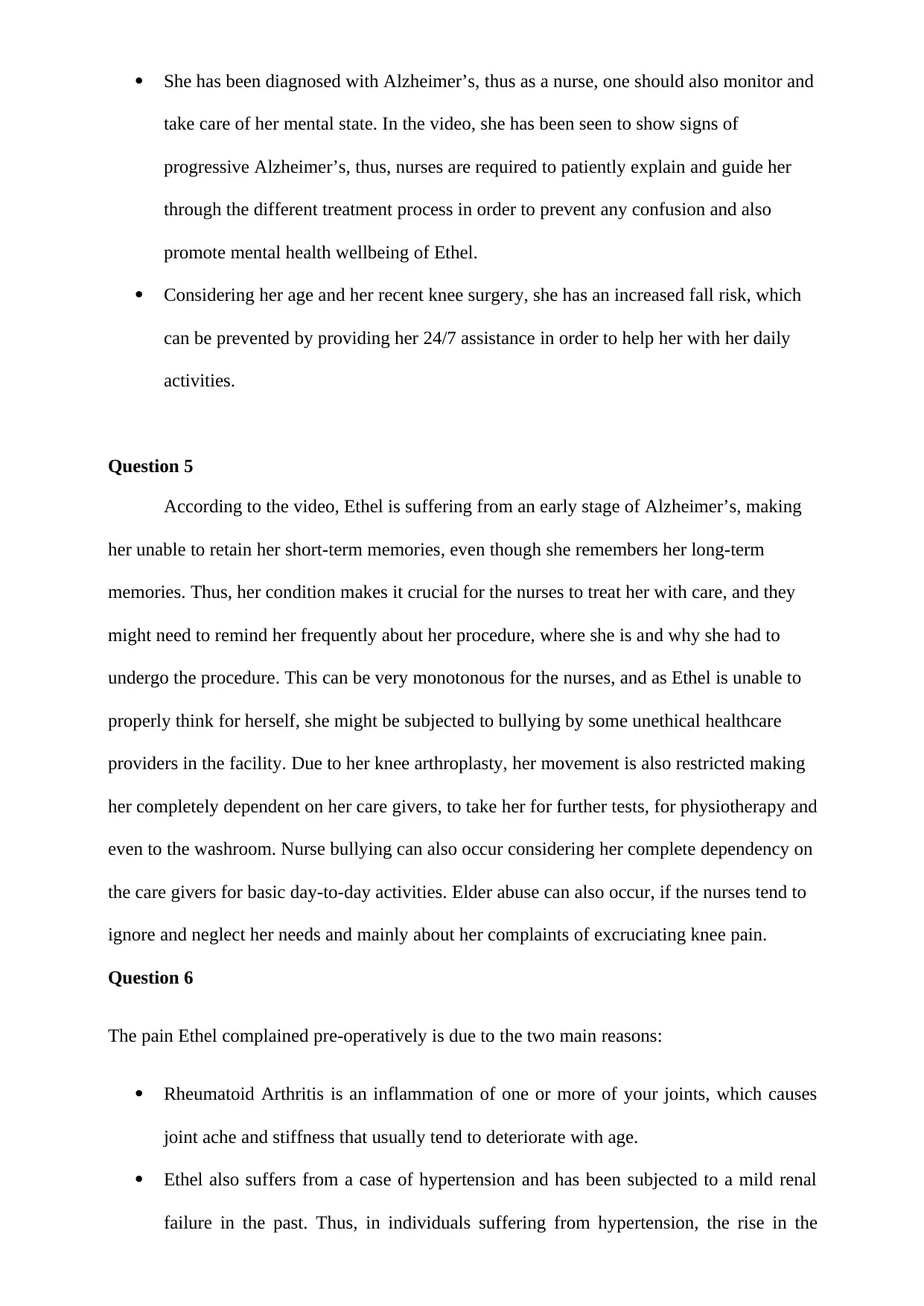
She has been diagnosed with Alzheimer’s, thus as a nurse, one should also monitor and
take care of her mental state. In the video, she has been seen to show signs of
progressive Alzheimer’s, thus, nurses are required to patiently explain and guide her
through the different treatment process in order to prevent any confusion and also
promote mental health wellbeing of Ethel.
Considering her age and her recent knee surgery, she has an increased fall risk, which
can be prevented by providing her 24/7 assistance in order to help her with her daily
activities.
Question 5
According to the video, Ethel is suffering from an early stage of Alzheimer’s, making
her unable to retain her short-term memories, even though she remembers her long-term
memories. Thus, her condition makes it crucial for the nurses to treat her with care, and they
might need to remind her frequently about her procedure, where she is and why she had to
undergo the procedure. This can be very monotonous for the nurses, and as Ethel is unable to
properly think for herself, she might be subjected to bullying by some unethical healthcare
providers in the facility. Due to her knee arthroplasty, her movement is also restricted making
her completely dependent on her care givers, to take her for further tests, for physiotherapy and
even to the washroom. Nurse bullying can also occur considering her complete dependency on
the care givers for basic day-to-day activities. Elder abuse can also occur, if the nurses tend to
ignore and neglect her needs and mainly about her complaints of excruciating knee pain.
Question 6
The pain Ethel complained pre-operatively is due to the two main reasons:
Rheumatoid Arthritis is an inflammation of one or more of your joints, which causes
joint ache and stiffness that usually tend to deteriorate with age.
Ethel also suffers from a case of hypertension and has been subjected to a mild renal
failure in the past. Thus, in individuals suffering from hypertension, the rise in the
take care of her mental state. In the video, she has been seen to show signs of
progressive Alzheimer’s, thus, nurses are required to patiently explain and guide her
through the different treatment process in order to prevent any confusion and also
promote mental health wellbeing of Ethel.
Considering her age and her recent knee surgery, she has an increased fall risk, which
can be prevented by providing her 24/7 assistance in order to help her with her daily
activities.
Question 5
According to the video, Ethel is suffering from an early stage of Alzheimer’s, making
her unable to retain her short-term memories, even though she remembers her long-term
memories. Thus, her condition makes it crucial for the nurses to treat her with care, and they
might need to remind her frequently about her procedure, where she is and why she had to
undergo the procedure. This can be very monotonous for the nurses, and as Ethel is unable to
properly think for herself, she might be subjected to bullying by some unethical healthcare
providers in the facility. Due to her knee arthroplasty, her movement is also restricted making
her completely dependent on her care givers, to take her for further tests, for physiotherapy and
even to the washroom. Nurse bullying can also occur considering her complete dependency on
the care givers for basic day-to-day activities. Elder abuse can also occur, if the nurses tend to
ignore and neglect her needs and mainly about her complaints of excruciating knee pain.
Question 6
The pain Ethel complained pre-operatively is due to the two main reasons:
Rheumatoid Arthritis is an inflammation of one or more of your joints, which causes
joint ache and stiffness that usually tend to deteriorate with age.
Ethel also suffers from a case of hypertension and has been subjected to a mild renal
failure in the past. Thus, in individuals suffering from hypertension, the rise in the
Secure Best Marks with AI Grader
Need help grading? Try our AI Grader for instant feedback on your assignments.
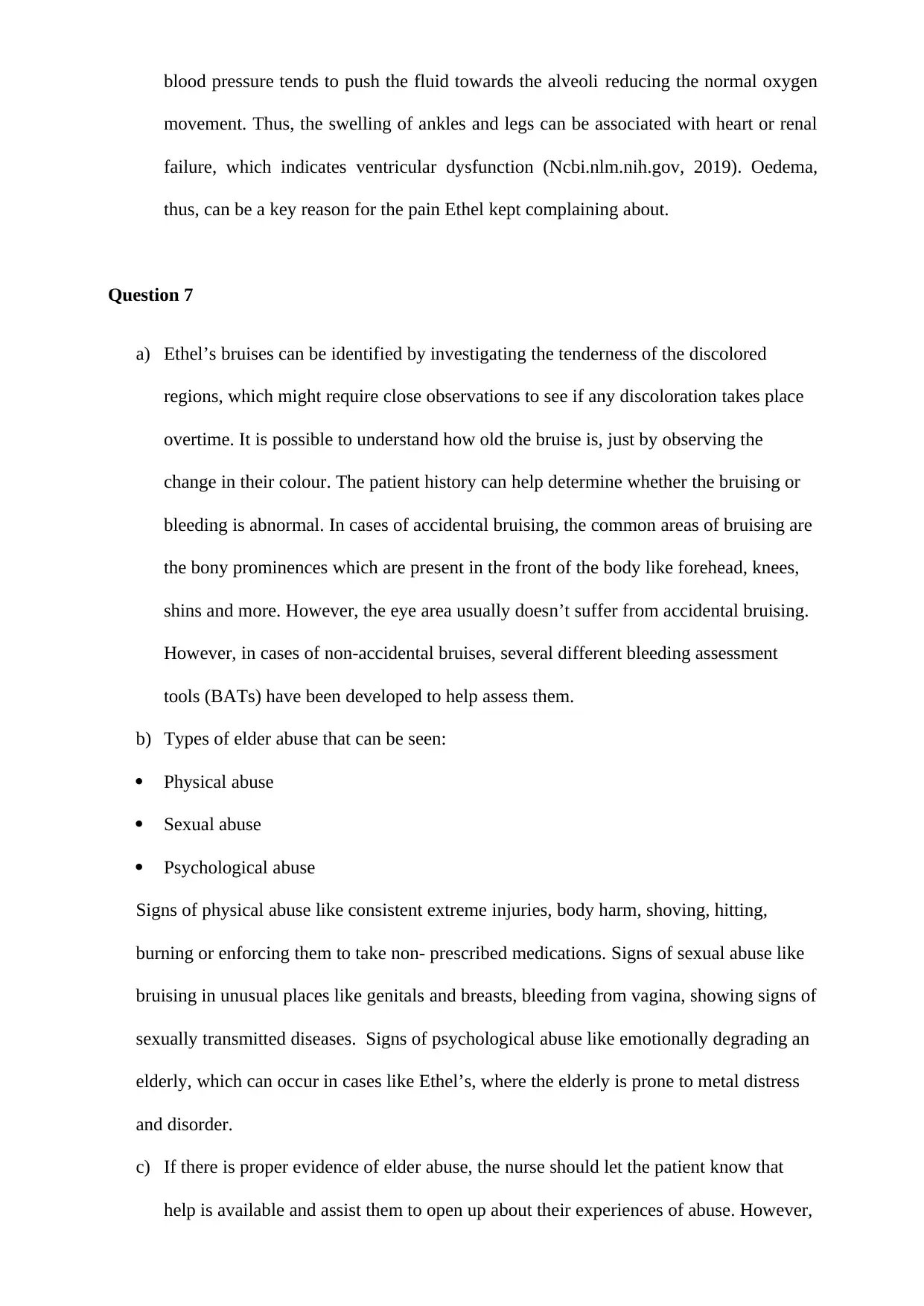
blood pressure tends to push the fluid towards the alveoli reducing the normal oxygen
movement. Thus, the swelling of ankles and legs can be associated with heart or renal
failure, which indicates ventricular dysfunction (Ncbi.nlm.nih.gov, 2019). Oedema,
thus, can be a key reason for the pain Ethel kept complaining about.
Question 7
a) Ethel’s bruises can be identified by investigating the tenderness of the discolored
regions, which might require close observations to see if any discoloration takes place
overtime. It is possible to understand how old the bruise is, just by observing the
change in their colour. The patient history can help determine whether the bruising or
bleeding is abnormal. In cases of accidental bruising, the common areas of bruising are
the bony prominences which are present in the front of the body like forehead, knees,
shins and more. However, the eye area usually doesn’t suffer from accidental bruising.
However, in cases of non-accidental bruises, several different bleeding assessment
tools (BATs) have been developed to help assess them.
b) Types of elder abuse that can be seen:
Physical abuse
Sexual abuse
Psychological abuse
Signs of physical abuse like consistent extreme injuries, body harm, shoving, hitting,
burning or enforcing them to take non- prescribed medications. Signs of sexual abuse like
bruising in unusual places like genitals and breasts, bleeding from vagina, showing signs of
sexually transmitted diseases. Signs of psychological abuse like emotionally degrading an
elderly, which can occur in cases like Ethel’s, where the elderly is prone to metal distress
and disorder.
c) If there is proper evidence of elder abuse, the nurse should let the patient know that
help is available and assist them to open up about their experiences of abuse. However,
movement. Thus, the swelling of ankles and legs can be associated with heart or renal
failure, which indicates ventricular dysfunction (Ncbi.nlm.nih.gov, 2019). Oedema,
thus, can be a key reason for the pain Ethel kept complaining about.
Question 7
a) Ethel’s bruises can be identified by investigating the tenderness of the discolored
regions, which might require close observations to see if any discoloration takes place
overtime. It is possible to understand how old the bruise is, just by observing the
change in their colour. The patient history can help determine whether the bruising or
bleeding is abnormal. In cases of accidental bruising, the common areas of bruising are
the bony prominences which are present in the front of the body like forehead, knees,
shins and more. However, the eye area usually doesn’t suffer from accidental bruising.
However, in cases of non-accidental bruises, several different bleeding assessment
tools (BATs) have been developed to help assess them.
b) Types of elder abuse that can be seen:
Physical abuse
Sexual abuse
Psychological abuse
Signs of physical abuse like consistent extreme injuries, body harm, shoving, hitting,
burning or enforcing them to take non- prescribed medications. Signs of sexual abuse like
bruising in unusual places like genitals and breasts, bleeding from vagina, showing signs of
sexually transmitted diseases. Signs of psychological abuse like emotionally degrading an
elderly, which can occur in cases like Ethel’s, where the elderly is prone to metal distress
and disorder.
c) If there is proper evidence of elder abuse, the nurse should let the patient know that
help is available and assist them to open up about their experiences of abuse. However,
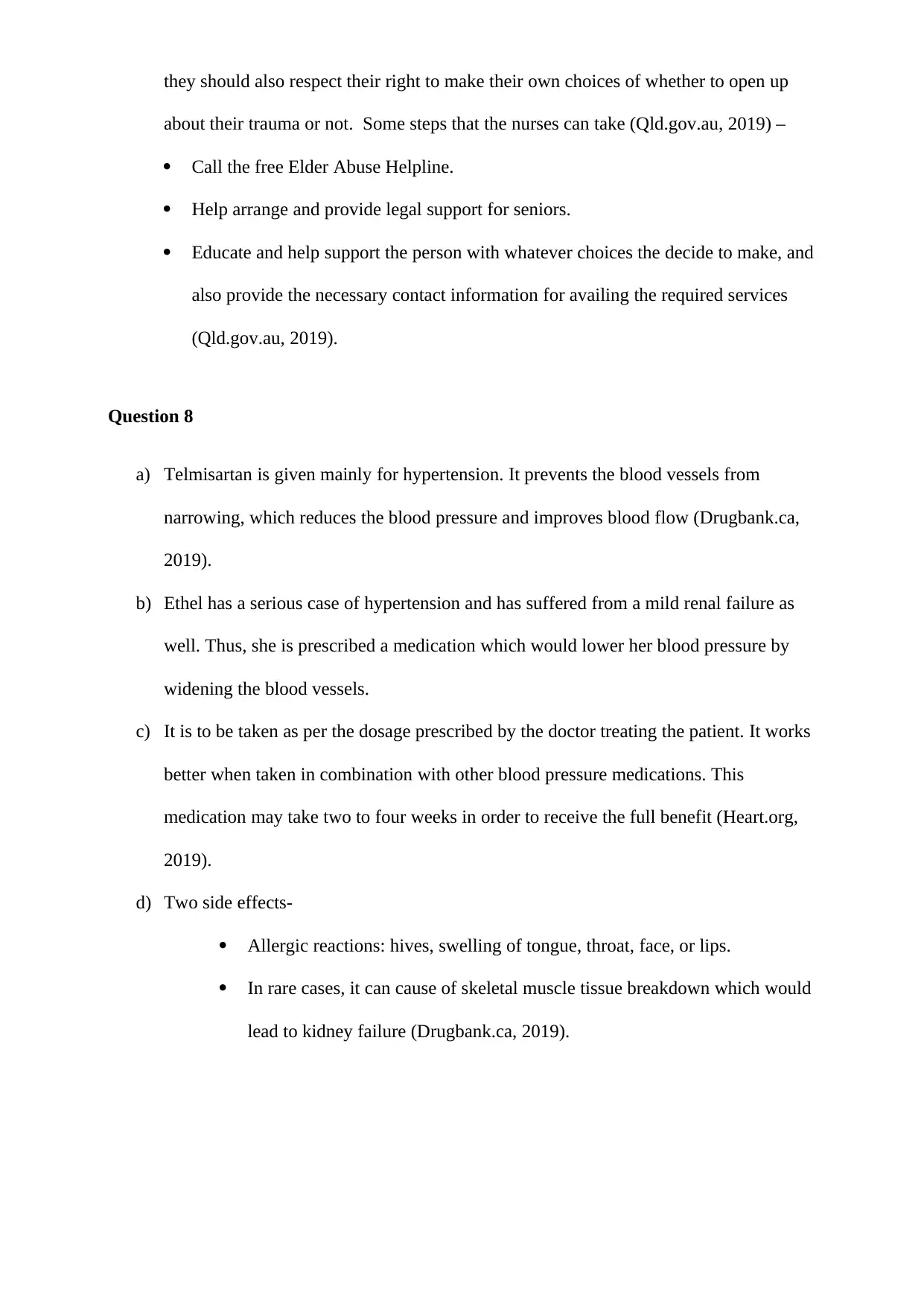
they should also respect their right to make their own choices of whether to open up
about their trauma or not. Some steps that the nurses can take (Qld.gov.au, 2019) –
Call the free Elder Abuse Helpline.
Help arrange and provide legal support for seniors.
Educate and help support the person with whatever choices the decide to make, and
also provide the necessary contact information for availing the required services
(Qld.gov.au, 2019).
Question 8
a) Telmisartan is given mainly for hypertension. It prevents the blood vessels from
narrowing, which reduces the blood pressure and improves blood flow (Drugbank.ca,
2019).
b) Ethel has a serious case of hypertension and has suffered from a mild renal failure as
well. Thus, she is prescribed a medication which would lower her blood pressure by
widening the blood vessels.
c) It is to be taken as per the dosage prescribed by the doctor treating the patient. It works
better when taken in combination with other blood pressure medications. This
medication may take two to four weeks in order to receive the full benefit (Heart.org,
2019).
d) Two side effects-
Allergic reactions: hives, swelling of tongue, throat, face, or lips.
In rare cases, it can cause of skeletal muscle tissue breakdown which would
lead to kidney failure (Drugbank.ca, 2019).
about their trauma or not. Some steps that the nurses can take (Qld.gov.au, 2019) –
Call the free Elder Abuse Helpline.
Help arrange and provide legal support for seniors.
Educate and help support the person with whatever choices the decide to make, and
also provide the necessary contact information for availing the required services
(Qld.gov.au, 2019).
Question 8
a) Telmisartan is given mainly for hypertension. It prevents the blood vessels from
narrowing, which reduces the blood pressure and improves blood flow (Drugbank.ca,
2019).
b) Ethel has a serious case of hypertension and has suffered from a mild renal failure as
well. Thus, she is prescribed a medication which would lower her blood pressure by
widening the blood vessels.
c) It is to be taken as per the dosage prescribed by the doctor treating the patient. It works
better when taken in combination with other blood pressure medications. This
medication may take two to four weeks in order to receive the full benefit (Heart.org,
2019).
d) Two side effects-
Allergic reactions: hives, swelling of tongue, throat, face, or lips.
In rare cases, it can cause of skeletal muscle tissue breakdown which would
lead to kidney failure (Drugbank.ca, 2019).
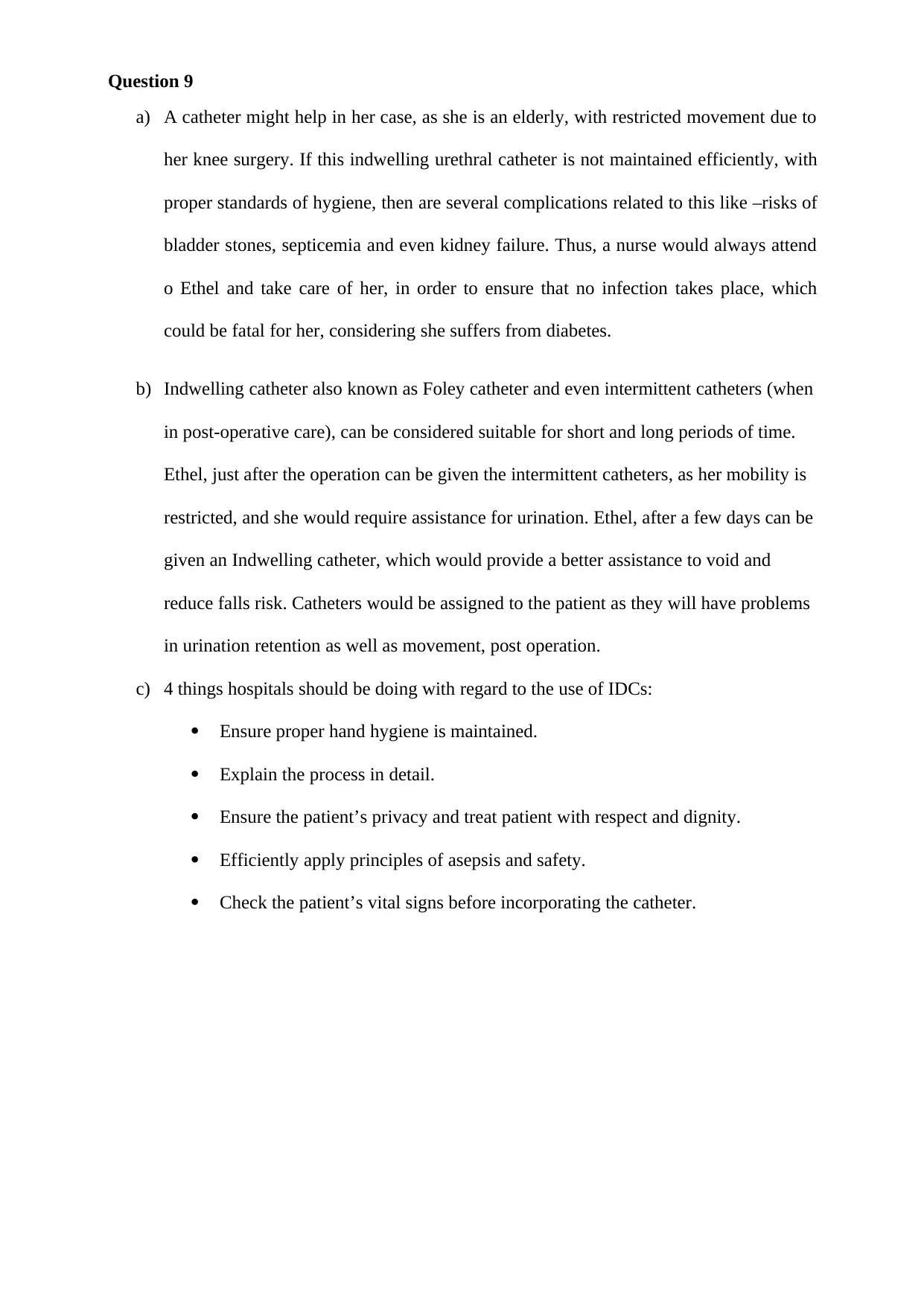
Question 9
a) A catheter might help in her case, as she is an elderly, with restricted movement due to
her knee surgery. If this indwelling urethral catheter is not maintained efficiently, with
proper standards of hygiene, then are several complications related to this like –risks of
bladder stones, septicemia and even kidney failure. Thus, a nurse would always attend
o Ethel and take care of her, in order to ensure that no infection takes place, which
could be fatal for her, considering she suffers from diabetes.
b) Indwelling catheter also known as Foley catheter and even intermittent catheters (when
in post-operative care), can be considered suitable for short and long periods of time.
Ethel, just after the operation can be given the intermittent catheters, as her mobility is
restricted, and she would require assistance for urination. Ethel, after a few days can be
given an Indwelling catheter, which would provide a better assistance to void and
reduce falls risk. Catheters would be assigned to the patient as they will have problems
in urination retention as well as movement, post operation.
c) 4 things hospitals should be doing with regard to the use of IDCs:
Ensure proper hand hygiene is maintained.
Explain the process in detail.
Ensure the patient’s privacy and treat patient with respect and dignity.
Efficiently apply principles of asepsis and safety.
Check the patient’s vital signs before incorporating the catheter.
a) A catheter might help in her case, as she is an elderly, with restricted movement due to
her knee surgery. If this indwelling urethral catheter is not maintained efficiently, with
proper standards of hygiene, then are several complications related to this like –risks of
bladder stones, septicemia and even kidney failure. Thus, a nurse would always attend
o Ethel and take care of her, in order to ensure that no infection takes place, which
could be fatal for her, considering she suffers from diabetes.
b) Indwelling catheter also known as Foley catheter and even intermittent catheters (when
in post-operative care), can be considered suitable for short and long periods of time.
Ethel, just after the operation can be given the intermittent catheters, as her mobility is
restricted, and she would require assistance for urination. Ethel, after a few days can be
given an Indwelling catheter, which would provide a better assistance to void and
reduce falls risk. Catheters would be assigned to the patient as they will have problems
in urination retention as well as movement, post operation.
c) 4 things hospitals should be doing with regard to the use of IDCs:
Ensure proper hand hygiene is maintained.
Explain the process in detail.
Ensure the patient’s privacy and treat patient with respect and dignity.
Efficiently apply principles of asepsis and safety.
Check the patient’s vital signs before incorporating the catheter.
Paraphrase This Document
Need a fresh take? Get an instant paraphrase of this document with our AI Paraphraser
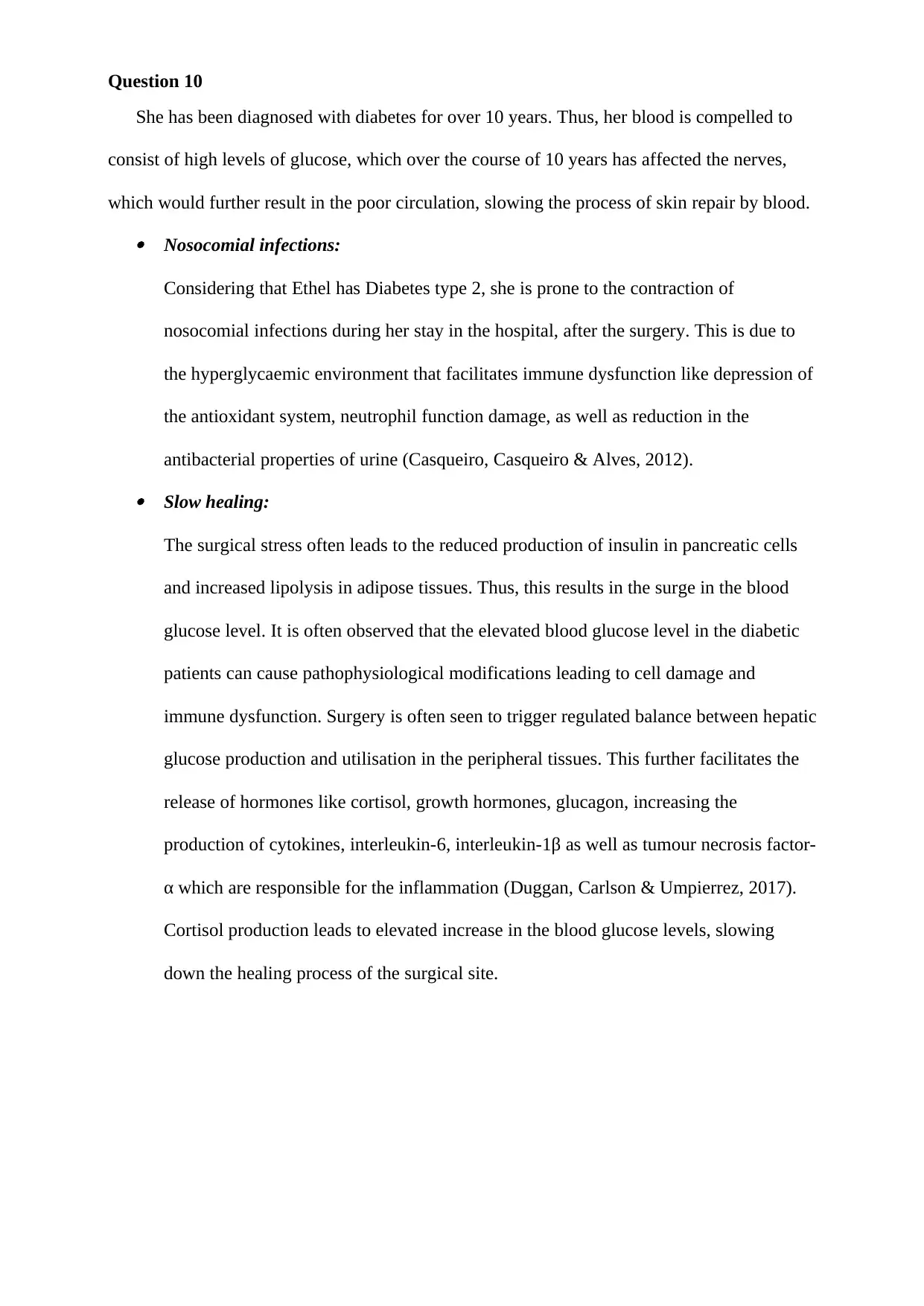
Question 10
She has been diagnosed with diabetes for over 10 years. Thus, her blood is compelled to
consist of high levels of glucose, which over the course of 10 years has affected the nerves,
which would further result in the poor circulation, slowing the process of skin repair by blood. Nosocomial infections:
Considering that Ethel has Diabetes type 2, she is prone to the contraction of
nosocomial infections during her stay in the hospital, after the surgery. This is due to
the hyperglycaemic environment that facilitates immune dysfunction like depression of
the antioxidant system, neutrophil function damage, as well as reduction in the
antibacterial properties of urine (Casqueiro, Casqueiro & Alves, 2012). Slow healing:
The surgical stress often leads to the reduced production of insulin in pancreatic cells
and increased lipolysis in adipose tissues. Thus, this results in the surge in the blood
glucose level. It is often observed that the elevated blood glucose level in the diabetic
patients can cause pathophysiological modifications leading to cell damage and
immune dysfunction. Surgery is often seen to trigger regulated balance between hepatic
glucose production and utilisation in the peripheral tissues. This further facilitates the
release of hormones like cortisol, growth hormones, glucagon, increasing the
production of cytokines, interleukin-6, interleukin-1β as well as tumour necrosis factor-
α which are responsible for the inflammation (Duggan, Carlson & Umpierrez, 2017).
Cortisol production leads to elevated increase in the blood glucose levels, slowing
down the healing process of the surgical site.
She has been diagnosed with diabetes for over 10 years. Thus, her blood is compelled to
consist of high levels of glucose, which over the course of 10 years has affected the nerves,
which would further result in the poor circulation, slowing the process of skin repair by blood. Nosocomial infections:
Considering that Ethel has Diabetes type 2, she is prone to the contraction of
nosocomial infections during her stay in the hospital, after the surgery. This is due to
the hyperglycaemic environment that facilitates immune dysfunction like depression of
the antioxidant system, neutrophil function damage, as well as reduction in the
antibacterial properties of urine (Casqueiro, Casqueiro & Alves, 2012). Slow healing:
The surgical stress often leads to the reduced production of insulin in pancreatic cells
and increased lipolysis in adipose tissues. Thus, this results in the surge in the blood
glucose level. It is often observed that the elevated blood glucose level in the diabetic
patients can cause pathophysiological modifications leading to cell damage and
immune dysfunction. Surgery is often seen to trigger regulated balance between hepatic
glucose production and utilisation in the peripheral tissues. This further facilitates the
release of hormones like cortisol, growth hormones, glucagon, increasing the
production of cytokines, interleukin-6, interleukin-1β as well as tumour necrosis factor-
α which are responsible for the inflammation (Duggan, Carlson & Umpierrez, 2017).
Cortisol production leads to elevated increase in the blood glucose levels, slowing
down the healing process of the surgical site.
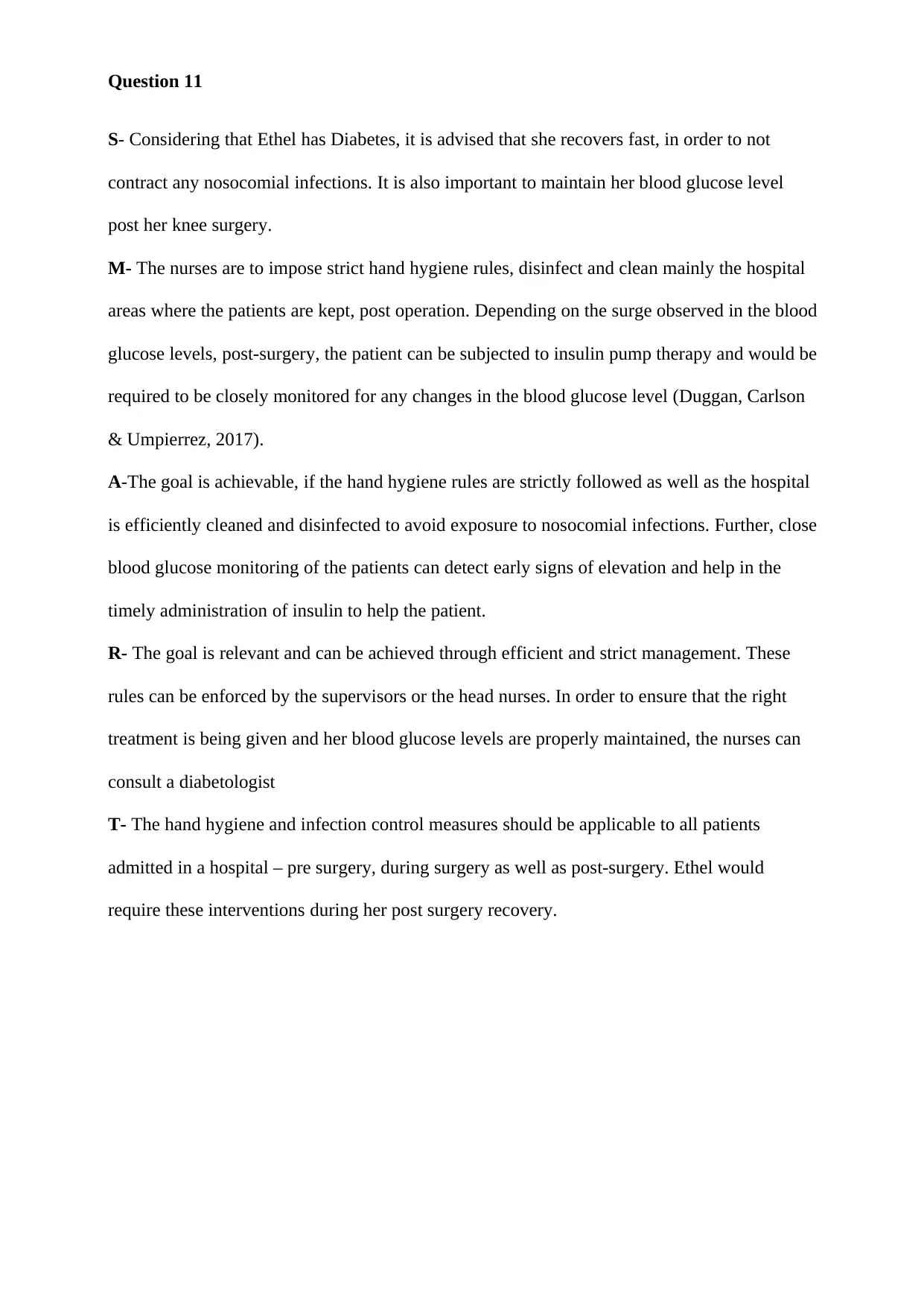
Question 11
S- Considering that Ethel has Diabetes, it is advised that she recovers fast, in order to not
contract any nosocomial infections. It is also important to maintain her blood glucose level
post her knee surgery.
M- The nurses are to impose strict hand hygiene rules, disinfect and clean mainly the hospital
areas where the patients are kept, post operation. Depending on the surge observed in the blood
glucose levels, post-surgery, the patient can be subjected to insulin pump therapy and would be
required to be closely monitored for any changes in the blood glucose level (Duggan, Carlson
& Umpierrez, 2017).
A-The goal is achievable, if the hand hygiene rules are strictly followed as well as the hospital
is efficiently cleaned and disinfected to avoid exposure to nosocomial infections. Further, close
blood glucose monitoring of the patients can detect early signs of elevation and help in the
timely administration of insulin to help the patient.
R- The goal is relevant and can be achieved through efficient and strict management. These
rules can be enforced by the supervisors or the head nurses. In order to ensure that the right
treatment is being given and her blood glucose levels are properly maintained, the nurses can
consult a diabetologist
T- The hand hygiene and infection control measures should be applicable to all patients
admitted in a hospital – pre surgery, during surgery as well as post-surgery. Ethel would
require these interventions during her post surgery recovery.
S- Considering that Ethel has Diabetes, it is advised that she recovers fast, in order to not
contract any nosocomial infections. It is also important to maintain her blood glucose level
post her knee surgery.
M- The nurses are to impose strict hand hygiene rules, disinfect and clean mainly the hospital
areas where the patients are kept, post operation. Depending on the surge observed in the blood
glucose levels, post-surgery, the patient can be subjected to insulin pump therapy and would be
required to be closely monitored for any changes in the blood glucose level (Duggan, Carlson
& Umpierrez, 2017).
A-The goal is achievable, if the hand hygiene rules are strictly followed as well as the hospital
is efficiently cleaned and disinfected to avoid exposure to nosocomial infections. Further, close
blood glucose monitoring of the patients can detect early signs of elevation and help in the
timely administration of insulin to help the patient.
R- The goal is relevant and can be achieved through efficient and strict management. These
rules can be enforced by the supervisors or the head nurses. In order to ensure that the right
treatment is being given and her blood glucose levels are properly maintained, the nurses can
consult a diabetologist
T- The hand hygiene and infection control measures should be applicable to all patients
admitted in a hospital – pre surgery, during surgery as well as post-surgery. Ethel would
require these interventions during her post surgery recovery.
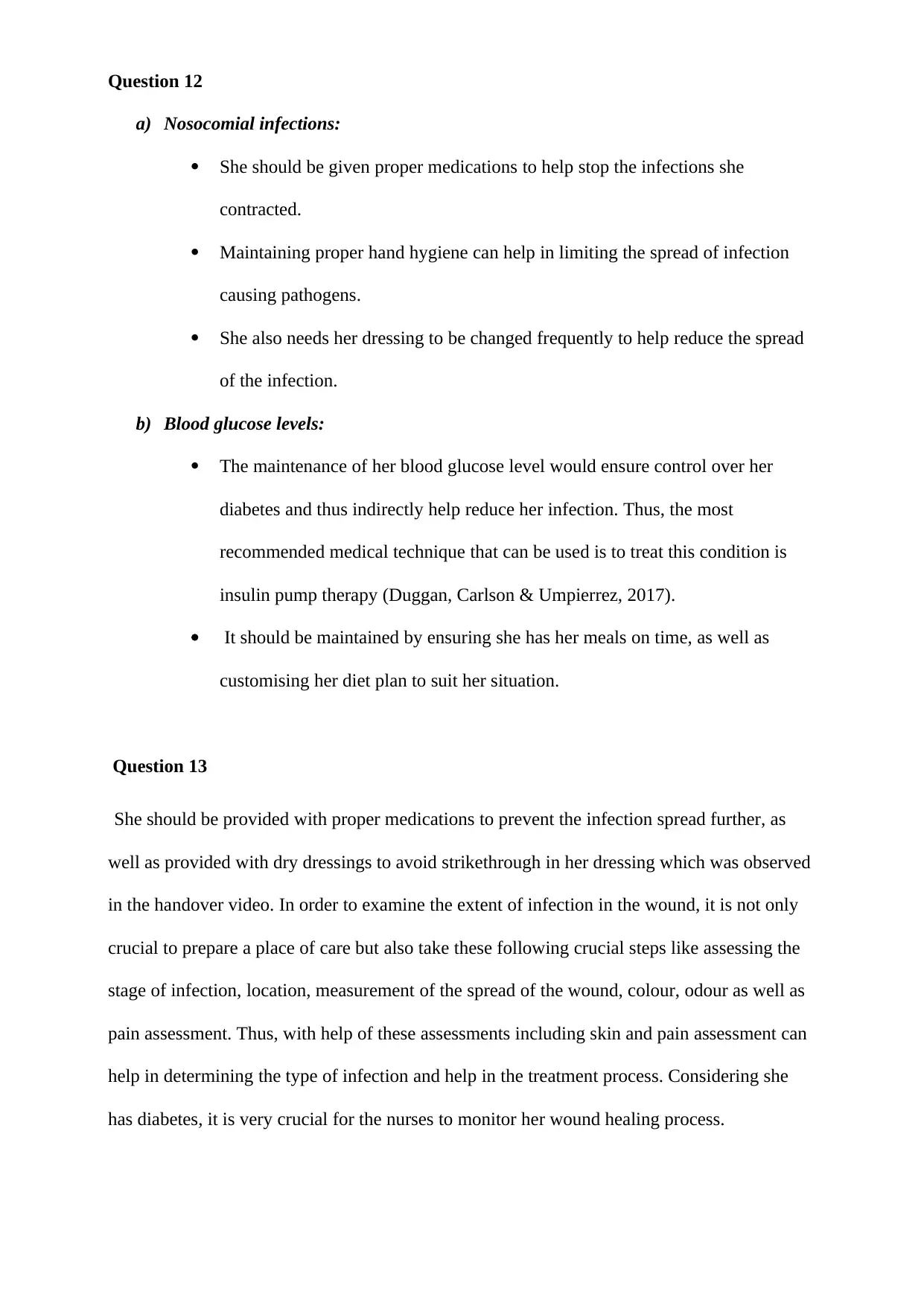
Question 12
a) Nosocomial infections:
She should be given proper medications to help stop the infections she
contracted.
Maintaining proper hand hygiene can help in limiting the spread of infection
causing pathogens.
She also needs her dressing to be changed frequently to help reduce the spread
of the infection.
b) Blood glucose levels:
The maintenance of her blood glucose level would ensure control over her
diabetes and thus indirectly help reduce her infection. Thus, the most
recommended medical technique that can be used is to treat this condition is
insulin pump therapy (Duggan, Carlson & Umpierrez, 2017).
It should be maintained by ensuring she has her meals on time, as well as
customising her diet plan to suit her situation.
Question 13
She should be provided with proper medications to prevent the infection spread further, as
well as provided with dry dressings to avoid strikethrough in her dressing which was observed
in the handover video. In order to examine the extent of infection in the wound, it is not only
crucial to prepare a place of care but also take these following crucial steps like assessing the
stage of infection, location, measurement of the spread of the wound, colour, odour as well as
pain assessment. Thus, with help of these assessments including skin and pain assessment can
help in determining the type of infection and help in the treatment process. Considering she
has diabetes, it is very crucial for the nurses to monitor her wound healing process.
a) Nosocomial infections:
She should be given proper medications to help stop the infections she
contracted.
Maintaining proper hand hygiene can help in limiting the spread of infection
causing pathogens.
She also needs her dressing to be changed frequently to help reduce the spread
of the infection.
b) Blood glucose levels:
The maintenance of her blood glucose level would ensure control over her
diabetes and thus indirectly help reduce her infection. Thus, the most
recommended medical technique that can be used is to treat this condition is
insulin pump therapy (Duggan, Carlson & Umpierrez, 2017).
It should be maintained by ensuring she has her meals on time, as well as
customising her diet plan to suit her situation.
Question 13
She should be provided with proper medications to prevent the infection spread further, as
well as provided with dry dressings to avoid strikethrough in her dressing which was observed
in the handover video. In order to examine the extent of infection in the wound, it is not only
crucial to prepare a place of care but also take these following crucial steps like assessing the
stage of infection, location, measurement of the spread of the wound, colour, odour as well as
pain assessment. Thus, with help of these assessments including skin and pain assessment can
help in determining the type of infection and help in the treatment process. Considering she
has diabetes, it is very crucial for the nurses to monitor her wound healing process.
Secure Best Marks with AI Grader
Need help grading? Try our AI Grader for instant feedback on your assignments.
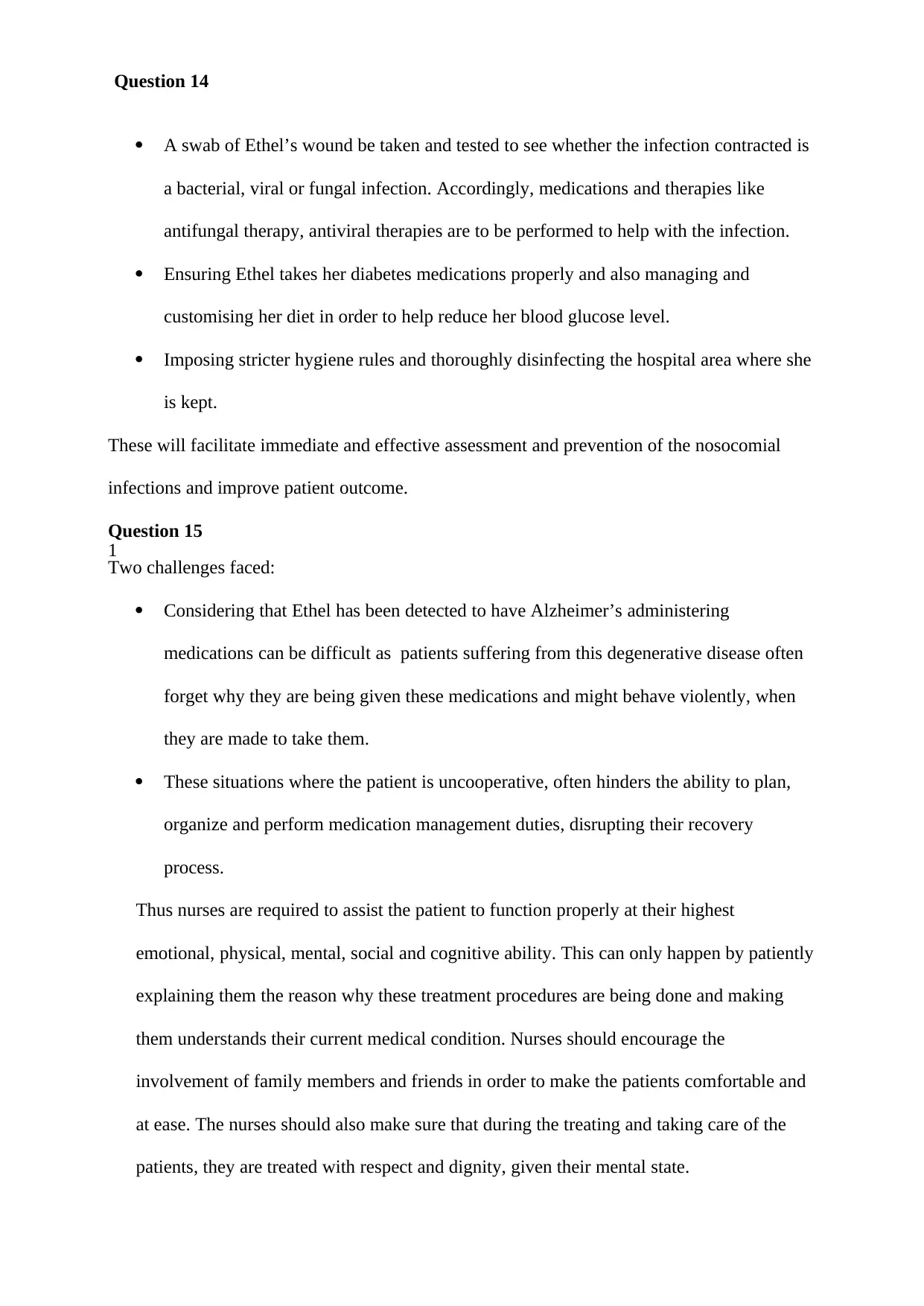
Question 14
A swab of Ethel’s wound be taken and tested to see whether the infection contracted is
a bacterial, viral or fungal infection. Accordingly, medications and therapies like
antifungal therapy, antiviral therapies are to be performed to help with the infection.
Ensuring Ethel takes her diabetes medications properly and also managing and
customising her diet in order to help reduce her blood glucose level.
Imposing stricter hygiene rules and thoroughly disinfecting the hospital area where she
is kept.
These will facilitate immediate and effective assessment and prevention of the nosocomial
infections and improve patient outcome.
Question 15
1
Two challenges faced:
Considering that Ethel has been detected to have Alzheimer’s administering
medications can be difficult as patients suffering from this degenerative disease often
forget why they are being given these medications and might behave violently, when
they are made to take them.
These situations where the patient is uncooperative, often hinders the ability to plan,
organize and perform medication management duties, disrupting their recovery
process.
Thus nurses are required to assist the patient to function properly at their highest
emotional, physical, mental, social and cognitive ability. This can only happen by patiently
explaining them the reason why these treatment procedures are being done and making
them understands their current medical condition. Nurses should encourage the
involvement of family members and friends in order to make the patients comfortable and
at ease. The nurses should also make sure that during the treating and taking care of the
patients, they are treated with respect and dignity, given their mental state.
A swab of Ethel’s wound be taken and tested to see whether the infection contracted is
a bacterial, viral or fungal infection. Accordingly, medications and therapies like
antifungal therapy, antiviral therapies are to be performed to help with the infection.
Ensuring Ethel takes her diabetes medications properly and also managing and
customising her diet in order to help reduce her blood glucose level.
Imposing stricter hygiene rules and thoroughly disinfecting the hospital area where she
is kept.
These will facilitate immediate and effective assessment and prevention of the nosocomial
infections and improve patient outcome.
Question 15
1
Two challenges faced:
Considering that Ethel has been detected to have Alzheimer’s administering
medications can be difficult as patients suffering from this degenerative disease often
forget why they are being given these medications and might behave violently, when
they are made to take them.
These situations where the patient is uncooperative, often hinders the ability to plan,
organize and perform medication management duties, disrupting their recovery
process.
Thus nurses are required to assist the patient to function properly at their highest
emotional, physical, mental, social and cognitive ability. This can only happen by patiently
explaining them the reason why these treatment procedures are being done and making
them understands their current medical condition. Nurses should encourage the
involvement of family members and friends in order to make the patients comfortable and
at ease. The nurses should also make sure that during the treating and taking care of the
patients, they are treated with respect and dignity, given their mental state.
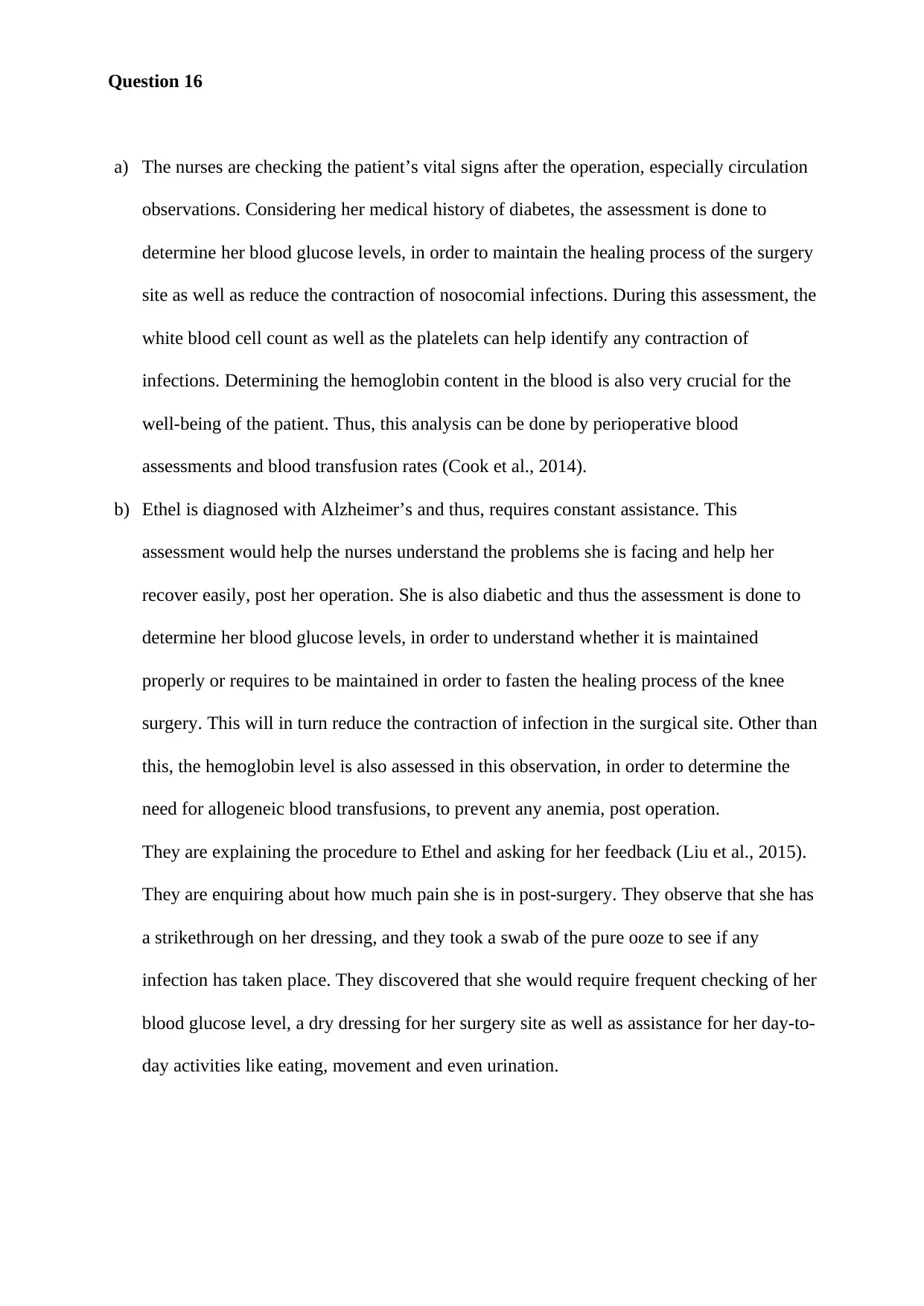
Question 16
a) The nurses are checking the patient’s vital signs after the operation, especially circulation
observations. Considering her medical history of diabetes, the assessment is done to
determine her blood glucose levels, in order to maintain the healing process of the surgery
site as well as reduce the contraction of nosocomial infections. During this assessment, the
white blood cell count as well as the platelets can help identify any contraction of
infections. Determining the hemoglobin content in the blood is also very crucial for the
well-being of the patient. Thus, this analysis can be done by perioperative blood
assessments and blood transfusion rates (Cook et al., 2014).
b) Ethel is diagnosed with Alzheimer’s and thus, requires constant assistance. This
assessment would help the nurses understand the problems she is facing and help her
recover easily, post her operation. She is also diabetic and thus the assessment is done to
determine her blood glucose levels, in order to understand whether it is maintained
properly or requires to be maintained in order to fasten the healing process of the knee
surgery. This will in turn reduce the contraction of infection in the surgical site. Other than
this, the hemoglobin level is also assessed in this observation, in order to determine the
need for allogeneic blood transfusions, to prevent any anemia, post operation.
They are explaining the procedure to Ethel and asking for her feedback (Liu et al., 2015).
They are enquiring about how much pain she is in post-surgery. They observe that she has
a strikethrough on her dressing, and they took a swab of the pure ooze to see if any
infection has taken place. They discovered that she would require frequent checking of her
blood glucose level, a dry dressing for her surgery site as well as assistance for her day-to-
day activities like eating, movement and even urination.
a) The nurses are checking the patient’s vital signs after the operation, especially circulation
observations. Considering her medical history of diabetes, the assessment is done to
determine her blood glucose levels, in order to maintain the healing process of the surgery
site as well as reduce the contraction of nosocomial infections. During this assessment, the
white blood cell count as well as the platelets can help identify any contraction of
infections. Determining the hemoglobin content in the blood is also very crucial for the
well-being of the patient. Thus, this analysis can be done by perioperative blood
assessments and blood transfusion rates (Cook et al., 2014).
b) Ethel is diagnosed with Alzheimer’s and thus, requires constant assistance. This
assessment would help the nurses understand the problems she is facing and help her
recover easily, post her operation. She is also diabetic and thus the assessment is done to
determine her blood glucose levels, in order to understand whether it is maintained
properly or requires to be maintained in order to fasten the healing process of the knee
surgery. This will in turn reduce the contraction of infection in the surgical site. Other than
this, the hemoglobin level is also assessed in this observation, in order to determine the
need for allogeneic blood transfusions, to prevent any anemia, post operation.
They are explaining the procedure to Ethel and asking for her feedback (Liu et al., 2015).
They are enquiring about how much pain she is in post-surgery. They observe that she has
a strikethrough on her dressing, and they took a swab of the pure ooze to see if any
infection has taken place. They discovered that she would require frequent checking of her
blood glucose level, a dry dressing for her surgery site as well as assistance for her day-to-
day activities like eating, movement and even urination.
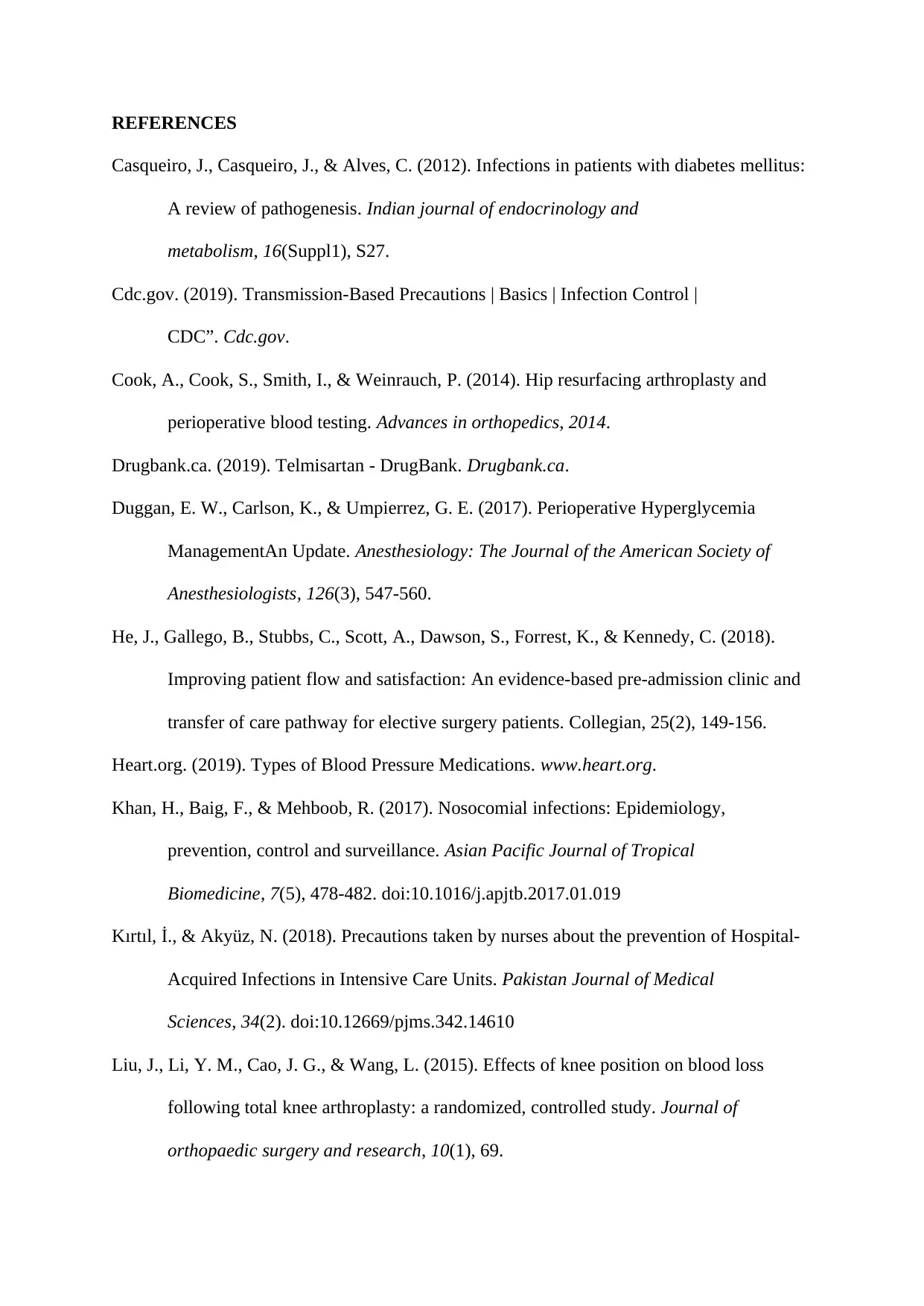
REFERENCES
Casqueiro, J., Casqueiro, J., & Alves, C. (2012). Infections in patients with diabetes mellitus:
A review of pathogenesis. Indian journal of endocrinology and
metabolism, 16(Suppl1), S27.
Cdc.gov. (2019). Transmission-Based Precautions | Basics | Infection Control |
CDC”. Cdc.gov.
Cook, A., Cook, S., Smith, I., & Weinrauch, P. (2014). Hip resurfacing arthroplasty and
perioperative blood testing. Advances in orthopedics, 2014.
Drugbank.ca. (2019). Telmisartan - DrugBank. Drugbank.ca.
Duggan, E. W., Carlson, K., & Umpierrez, G. E. (2017). Perioperative Hyperglycemia
ManagementAn Update. Anesthesiology: The Journal of the American Society of
Anesthesiologists, 126(3), 547-560.
He, J., Gallego, B., Stubbs, C., Scott, A., Dawson, S., Forrest, K., & Kennedy, C. (2018).
Improving patient flow and satisfaction: An evidence-based pre-admission clinic and
transfer of care pathway for elective surgery patients. Collegian, 25(2), 149-156.
Heart.org. (2019). Types of Blood Pressure Medications. www.heart.org.
Khan, H., Baig, F., & Mehboob, R. (2017). Nosocomial infections: Epidemiology,
prevention, control and surveillance. Asian Pacific Journal of Tropical
Biomedicine, 7(5), 478-482. doi:10.1016/j.apjtb.2017.01.019
Kırtıl, İ., & Akyüz, N. (2018). Precautions taken by nurses about the prevention of Hospital-
Acquired Infections in Intensive Care Units. Pakistan Journal of Medical
Sciences, 34(2). doi:10.12669/pjms.342.14610
Liu, J., Li, Y. M., Cao, J. G., & Wang, L. (2015). Effects of knee position on blood loss
following total knee arthroplasty: a randomized, controlled study. Journal of
orthopaedic surgery and research, 10(1), 69.
Casqueiro, J., Casqueiro, J., & Alves, C. (2012). Infections in patients with diabetes mellitus:
A review of pathogenesis. Indian journal of endocrinology and
metabolism, 16(Suppl1), S27.
Cdc.gov. (2019). Transmission-Based Precautions | Basics | Infection Control |
CDC”. Cdc.gov.
Cook, A., Cook, S., Smith, I., & Weinrauch, P. (2014). Hip resurfacing arthroplasty and
perioperative blood testing. Advances in orthopedics, 2014.
Drugbank.ca. (2019). Telmisartan - DrugBank. Drugbank.ca.
Duggan, E. W., Carlson, K., & Umpierrez, G. E. (2017). Perioperative Hyperglycemia
ManagementAn Update. Anesthesiology: The Journal of the American Society of
Anesthesiologists, 126(3), 547-560.
He, J., Gallego, B., Stubbs, C., Scott, A., Dawson, S., Forrest, K., & Kennedy, C. (2018).
Improving patient flow and satisfaction: An evidence-based pre-admission clinic and
transfer of care pathway for elective surgery patients. Collegian, 25(2), 149-156.
Heart.org. (2019). Types of Blood Pressure Medications. www.heart.org.
Khan, H., Baig, F., & Mehboob, R. (2017). Nosocomial infections: Epidemiology,
prevention, control and surveillance. Asian Pacific Journal of Tropical
Biomedicine, 7(5), 478-482. doi:10.1016/j.apjtb.2017.01.019
Kırtıl, İ., & Akyüz, N. (2018). Precautions taken by nurses about the prevention of Hospital-
Acquired Infections in Intensive Care Units. Pakistan Journal of Medical
Sciences, 34(2). doi:10.12669/pjms.342.14610
Liu, J., Li, Y. M., Cao, J. G., & Wang, L. (2015). Effects of knee position on blood loss
following total knee arthroplasty: a randomized, controlled study. Journal of
orthopaedic surgery and research, 10(1), 69.
Paraphrase This Document
Need a fresh take? Get an instant paraphrase of this document with our AI Paraphraser
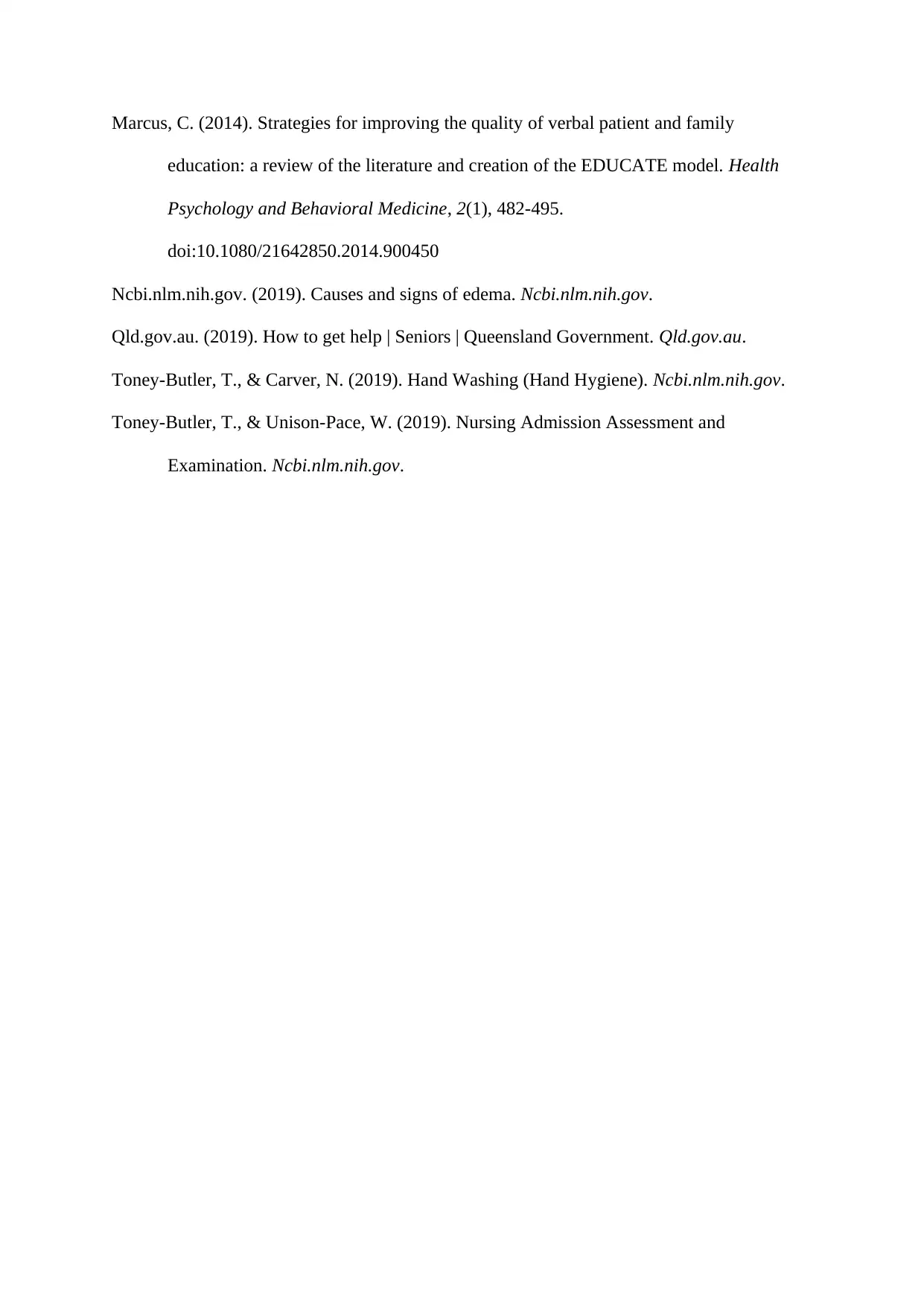
Marcus, C. (2014). Strategies for improving the quality of verbal patient and family
education: a review of the literature and creation of the EDUCATE model. Health
Psychology and Behavioral Medicine, 2(1), 482-495.
doi:10.1080/21642850.2014.900450
Ncbi.nlm.nih.gov. (2019). Causes and signs of edema. Ncbi.nlm.nih.gov.
Qld.gov.au. (2019). How to get help | Seniors | Queensland Government. Qld.gov.au.
Toney-Butler, T., & Carver, N. (2019). Hand Washing (Hand Hygiene). Ncbi.nlm.nih.gov.
Toney-Butler, T., & Unison-Pace, W. (2019). Nursing Admission Assessment and
Examination. Ncbi.nlm.nih.gov.
education: a review of the literature and creation of the EDUCATE model. Health
Psychology and Behavioral Medicine, 2(1), 482-495.
doi:10.1080/21642850.2014.900450
Ncbi.nlm.nih.gov. (2019). Causes and signs of edema. Ncbi.nlm.nih.gov.
Qld.gov.au. (2019). How to get help | Seniors | Queensland Government. Qld.gov.au.
Toney-Butler, T., & Carver, N. (2019). Hand Washing (Hand Hygiene). Ncbi.nlm.nih.gov.
Toney-Butler, T., & Unison-Pace, W. (2019). Nursing Admission Assessment and
Examination. Ncbi.nlm.nih.gov.
1 out of 14
Related Documents
Your All-in-One AI-Powered Toolkit for Academic Success.
+13062052269
info@desklib.com
Available 24*7 on WhatsApp / Email
![[object Object]](/_next/static/media/star-bottom.7253800d.svg)
Unlock your academic potential
© 2024 | Zucol Services PVT LTD | All rights reserved.





